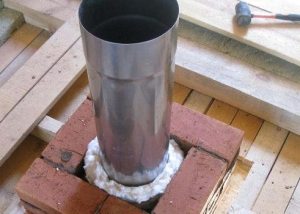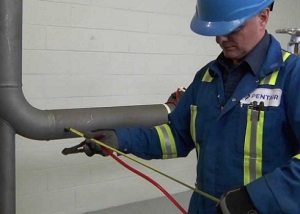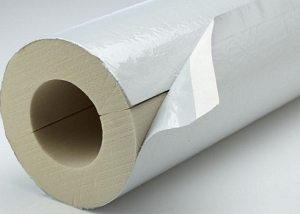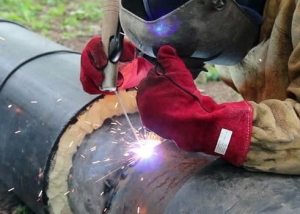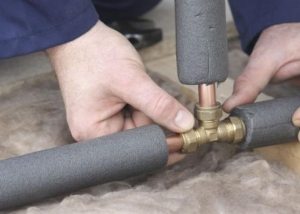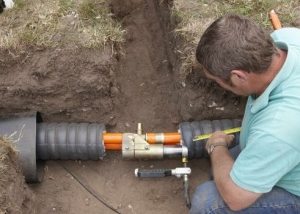In the absence of thermal insulation for pipes, rational transportation of the coolant through the main pipeline and branched system is impossible without lowering the temperature. But not only the heating system needs thermal insulation, any medium freezes in metal pipes in the cold, especially on the surface. Pipe insulation contributes to the rational use of heat during its transportation and redistribution. For proper thermal insulation of different sections of communications, the correct choice of material is important - for maximum protection of pipes from temperature extremes in the carrier.

Thermal insulation is an important point in the arrangement of water supply, heating and sewage systems
Content
Reasons for pipe insulation
Many do not understand why thermal insulation is necessary for pipes laid on the surface of the earth and in the open air. With the transportation of coolants, everything is clear - hot water should not cool down when delivered to the consumer. In this case, the term "thermal insulation" is more appropriate. But not only hot water must be protected from cooling.
Conventional plumbing forms condensation on the surface with a temperature contrast, and also freezes in the winter, especially with extreme thermometer readings. This often happens in the aerial parts of old columns, equipped in the private sector and rural areas. In this case, the frozen water is heated with a blowtorch or other methods.
Low air temperatures make it necessary to maintain the thermal performance of the coolant when supplied to the objects. All types of pipes are insulated, regardless of material:
- metal;
- metal-plastic;
- plastic;
- polymer;
- composite.
It is interesting! In a cold climate, traditional insulation of communications on the part that goes along the surface of the earth is not enough. In Scandinavia, they proposed heating steps on houses and shops, sidewalks and pipes for the heating system with a Nexans heating cable. Gradually, this useful experience takes root on the territory of the Russian Federation.
In the private sector, there is a need for pipe insulation for various reasons:
- communications are brought to different buildings;
- part of the heating main goes along the street outdoors;
- heating fluid in a remote common boiler room;
- closed loop heating, through all the buildings on the household territory with different functionality and temperature inside (basement, garage, attic, bathhouse).
In some areas, additional pipe protection in thermal insulation is required. The reasons are hooligan manifestations and acts of vandalism, visits to the territory by wild animals or cattle. To do this, use an additional winding with sheet iron and a steel bar.
Basic requirements for pipe insulating materials
The round shape of the pipe implies a large area in contact with the external environment. Because of this, the coolant inside the communications cools relatively quickly. And the wider the pipe, the greater the heat transfer, so thoughtful pipe insulation is simply necessary.
Important requirements for insulating structures:
- dense porous material that does not absorb water;
- reliable protection against external influences and aggressive environments;
- counteracting overheating of the pipeline inside and freezing outside;
- long term of operation, irrespective of whether the external method of installation of communications is used - underground or channel.
The following are required for thermal protection for cold communications:
- light weight with residual density;
- fire resistance (non-combustible base);
affordable and quick installation; - cheap repair and dismantle;
- low price.
Thermal insulation options
Communications for transporting cold liquid media need additional protection. Even the most primitive pipe insulation prevents condensation, while preserving the line from corrosion and freezing. Protected pipes are less destroyed by pressure changes inside the pipeline, noise from the movement of the working medium is reduced significantly.
Foamed insulation. Thanks to closed light air bubbles, excellent thermal insulation is obtained. These products are offered in the form of convenient tubes or covers covering a pipe of any diameter. They are produced from various raw materials - rubber, polyurethane or polystyrene. Such insulation is easy to put on sections of the pipeline, because they have a finished longitudinal section.
Advice! When installing such thermal insulation on your own, try to process the ends on the cuts with any suitable mounting adhesive.
Mineral wool and fiberglass. The insulation is available in different forms, depending on the application. For pipes, cylindrical basalt wool insulation is most convenient. But with all the advantages of the material, it has a considerable cost. Under the thermal insulation for pipes in the basement, it is assumed that the sheet material is wrapped with a cord or construction tape.
- Glass wool or fiberglass insulation is made from quartz sand. It involves the protection of the skin of the hands and face when laying the material. This base is not used for very hot pipes due to its low efficiency.
- Basalt cotton wool is produced from mineral raw materials, so the name “Minvata” can often be seen in catalogs. Basalt insulation has a wide range of applications in construction, as it has proven itself in the insulation of pipes with a hot medium. For example, these are chimneys with an internal temperature of up to + 650 ° C, but even when overheated, the material is non-toxic and practically harmless.
Attention! In most countries, glass wool and fiberglass are not produced, as it is considered harmful to health and obsolete material. We continue to apply in the old-fashioned way (on external structures) - because of the affordable price and unacceptable for the reproduction of a living environment under isolation. But for such a material, an external coating is necessarily necessary - from roofing material or foil.

If a decision is made to insulate pipes with mineral wool, then it is better to take material with a factory external coating that does not allow moisture to pass through
Foil insulation. It features a reflective layer that reduces heat transfer. The processing of pipes with this material does not require knowledge of a special technology, therefore the work is easy to perform even for a layman.
Polyfoam and extruded polystyrene foam. These are related materials. For pipes of hot water supply routes during underground installation, one property is important - water resistance. Polyfoam has this property only partially, therefore it is more suitable for overhead communications and intermediate connection and branching of heating mains. The modern form of release is semi-cylindrical, which is very convenient for “covering” the insulated pipe. Styrofoam half-cylinders are better known as “shells”, which are widely used for pre-insulated pipes (with finished insulation).This is a universal and durable material with extremely low thermal conductivity, it is easy to stack, and is relatively inexpensive.
For communications in the attics it is better to use sprayed polystyrene foam. It is applied by a special device for surface treatment with a two-component mixture. This thermal insulation for pipes has excellent protective properties.
Penofol. This is a double self-adhesive foil insulation based on polyethylene foam, in which small air pores are closed. The reflective foil layer has protection against excessive adhesion and an adhesive layer.
Rubber insulation. It is also available in the form of tubes or half cylinders of foam material. The main advantage is elasticity, so they are often used for complex piping geometry. Universal insulation with the longest life, but requires a tight joint.
It is interesting! Attempts to create unique materials based on natural and synthetic rubber have been going on for more than 150 years. But the material is not widely used due to its high cost, however, it is appreciated by specialists due to its exceptional dielectric properties.
Features of the use of heaters in specific conditions
Pipe insulation must be carried out taking into account environmental conditions.
- When insulating communications in the attics, it should be borne in mind that this is a room with high humidity and purge. With a sharp cold snap, a negative temperature is possible, therefore it is important to exclude “cold bridges”. Basalt cotton and sprayed polystyrene foam are ideal. It is important to additionally provide for a good vapor barrier for the attic.
- Aluminum foil is not used separately as thermal insulation due to its high thermal conductivity. But as an additional layer or surface winding makes it possible to optimize the preservation of the temperature index of the coolant.
- Installation of pipe insulation during the installation of light country houses on unstable soils requires that all materials be as light as possible, including insulation. For example, basalt wool is heavier than quartz analogues, and it is rightly called "stone" wool. The lightest insulation is foam.
- For independent thermal insulation of a private house and its communications, it is easiest to work with pre-insulated pipes and self-adhesive insulation. To eliminate the shortcomings in the work, it is recommended to use an additional winding, for example, aluminum tape.
- Rigid semi-cylindrical heaters are designed for a pipe of a certain shape, so it is problematic to use them on narrower or wider pipes.
- When choosing a material for pipe insulation in adjacent sections (between heating systems, water supply and chimneys), experts recommend mineral wool in any convenient form of release.
Insulate the pipeline it is not difficult, but the effect of such actions largely depends on the correct choice of material and quality of installation. If everything is done correctly, then you can not worry about the performance of the highway for many years.



